Through the arts children can express, communicate, explore, imagine, and learn about culture and history. Drama, music, dance, and the visual arts strengthen students problem-solving and critical thinking skills, add to overall academic achievement and preparation for the work world. This week the International Reading Association Children's Literature and Reading Special Interest Group (CL/R SIG) shares recent titles around the theme of the arts.
GRADES K-3
Costanza, Stephen. (2012). Vivaldi and the invisible orchestra. New York: Henry Holt.
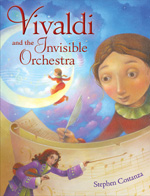 Antonio Vivaldi was the music master at the Ospedale della Pieta, an orphanage in Venice in the eighteenth century. Each day the young orphan girl, Candida, copied and transcribed Vivaldi’s work from his written scores onto sheets of music for his musicians. His musicians were the orphan girls from the school and they played behind a dark curtain during performances above the audience thus giving them the impression of an invisible orchestra. One day, Candida accidentally leaves one of her poems written along the sides of Vivaldi’s work in the sheets of music. On the following day when she picks up her daily scores to transcribe she discovers Vivaldi’s new concerto, The Four Seasons, based on the thoughts in her poem. The jewel-tone pastel illustrations add to the richness of this fairy tale-like story. Author notes at the end provide the back story about this little known incident in the life of the famous composer. Teachers might like to use the information about Vivaldi on Classics for Kids with a piece of the composition “The Four Seasons.”
Antonio Vivaldi was the music master at the Ospedale della Pieta, an orphanage in Venice in the eighteenth century. Each day the young orphan girl, Candida, copied and transcribed Vivaldi’s work from his written scores onto sheets of music for his musicians. His musicians were the orphan girls from the school and they played behind a dark curtain during performances above the audience thus giving them the impression of an invisible orchestra. One day, Candida accidentally leaves one of her poems written along the sides of Vivaldi’s work in the sheets of music. On the following day when she picks up her daily scores to transcribe she discovers Vivaldi’s new concerto, The Four Seasons, based on the thoughts in her poem. The jewel-tone pastel illustrations add to the richness of this fairy tale-like story. Author notes at the end provide the back story about this little known incident in the life of the famous composer. Teachers might like to use the information about Vivaldi on Classics for Kids with a piece of the composition “The Four Seasons.”
- Karen Hildebrand, Ohio Library and Reading Consultant
Danneberg, Julie. (2012) Monet paints a day. Illus. by Caitlin Heimerl. Watertown, MA: Charlesbridge.
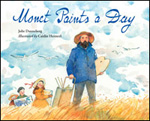 In the fall of 1885, Impressionist painter Claude Monet was staying at the coastal resort of Etretat, France. Told in first person and taken from his own writing and letters to his fiancée Alice, Monet talks about gathering his easels and paints and art supplies and hauling them all to the oceanside to paint. He uses local children to help with transporting all the painting materials that he needs. He is especially concerned with the light and the absolute correct time of day for the perfect lighting conditions. However, on this particular day, he fails to note the tides and he is completely washed up in the incoming high tide, supplies and all! Small, boxed paragraphs at the bottom of each page provide factual information about Monet, his life and work. Additional information about the artist is found appended at the end of the book. Teachers will find activities to extend this book at Kids Study Art. ReadWriteThink offers a lesson plan idea entitled “Artistic Elements: Exploring Art through Descriptive Writing.” Also, read Julie Dannenberg's posts "Teaching Tips: In Writing, Nothing is Wasted" and "Teaching Tips: The 'Fast and Furious' First Draft" on the Engage blog.
In the fall of 1885, Impressionist painter Claude Monet was staying at the coastal resort of Etretat, France. Told in first person and taken from his own writing and letters to his fiancée Alice, Monet talks about gathering his easels and paints and art supplies and hauling them all to the oceanside to paint. He uses local children to help with transporting all the painting materials that he needs. He is especially concerned with the light and the absolute correct time of day for the perfect lighting conditions. However, on this particular day, he fails to note the tides and he is completely washed up in the incoming high tide, supplies and all! Small, boxed paragraphs at the bottom of each page provide factual information about Monet, his life and work. Additional information about the artist is found appended at the end of the book. Teachers will find activities to extend this book at Kids Study Art. ReadWriteThink offers a lesson plan idea entitled “Artistic Elements: Exploring Art through Descriptive Writing.” Also, read Julie Dannenberg's posts "Teaching Tips: In Writing, Nothing is Wasted" and "Teaching Tips: The 'Fast and Furious' First Draft" on the Engage blog.
- Karen Hildebrand, Ohio Library and Reading Consultant
Geist, Ken. (2012). Who’s who? Illus. by Henry Cole. New York: Feiwel and Friends/ MacMillan.
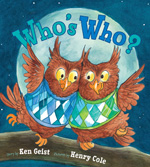 Based on the poem Over in the Meadow, this picture book will certainly be read and sung multiple times. Instead of a mother and child, this version has six sets of twins where the animals are from the barnyard, garden, jungle, pond, cave and sky. For example, “Over in the garden where the flowers grew and grew, lives a jumpy bunny sister and her twin brother, Lou.” On the next page the siblings are jumping over a log as they race other animals. The page contains speech bubbles with simple text for young children to read and sing along, “Hop!” Cole’s vibrant artwork is appealing and fun. The illustrations were created with acrylic paints and colored pencils. Visit www.henrycole.net to learn more.
Based on the poem Over in the Meadow, this picture book will certainly be read and sung multiple times. Instead of a mother and child, this version has six sets of twins where the animals are from the barnyard, garden, jungle, pond, cave and sky. For example, “Over in the garden where the flowers grew and grew, lives a jumpy bunny sister and her twin brother, Lou.” On the next page the siblings are jumping over a log as they race other animals. The page contains speech bubbles with simple text for young children to read and sing along, “Hop!” Cole’s vibrant artwork is appealing and fun. The illustrations were created with acrylic paints and colored pencils. Visit www.henrycole.net to learn more.
- Deanna Day, Washington State University Vancouver
Greenwood, Mark. (2012). Drummer boy of John John. Illus. by Frané Lessac. New York: Lee & Low.
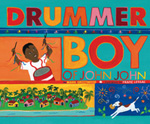 Based on the real life story of Winston “Spree” Simon, this story brings to life how determination and the spark of an idea can bring pleasing results. The book opens just weeks before Carnival in Trinidad. The Roti King has offered free rotis—tasty fried pancakes filled with chicken, herbs, and spices—as the grand prize for the best band in the Carnival parade. Winston dearly loves a good roti and is trying to figure out a way to win the grand prize but this is especially difficult because he does not belong to a band. As he is thinking he tosses his mango pit into the junkyard and it “pings” off a can. When Winston hears that sound, he tries other cans and lids to hear the different tones and sounds different sizes make. He continues to experiment with pots and pans and tins of all sorts. As neighbors and friends come out of their homes to listen, his friends join in and their band is formed. Author notes at the end of the book tell more about Winston Simon and his creation of the famed steel drums of Trinidad. Lessac’s gouache paintings resonate with the vibrant life of the Caribbean. Listen to the steel drum music of Trinidad.
Based on the real life story of Winston “Spree” Simon, this story brings to life how determination and the spark of an idea can bring pleasing results. The book opens just weeks before Carnival in Trinidad. The Roti King has offered free rotis—tasty fried pancakes filled with chicken, herbs, and spices—as the grand prize for the best band in the Carnival parade. Winston dearly loves a good roti and is trying to figure out a way to win the grand prize but this is especially difficult because he does not belong to a band. As he is thinking he tosses his mango pit into the junkyard and it “pings” off a can. When Winston hears that sound, he tries other cans and lids to hear the different tones and sounds different sizes make. He continues to experiment with pots and pans and tins of all sorts. As neighbors and friends come out of their homes to listen, his friends join in and their band is formed. Author notes at the end of the book tell more about Winston Simon and his creation of the famed steel drums of Trinidad. Lessac’s gouache paintings resonate with the vibrant life of the Caribbean. Listen to the steel drum music of Trinidad.
- Karen Hildebrand, Ohio Library and Reading Consultant
Hopman, Philip. (2012). Valentine and his violin. Translation by Claudius Translations, Dave Cooper and Vincent Janssen Steenberg. Honesdale, PA: Lemniscaat/Boyds Mill Press.
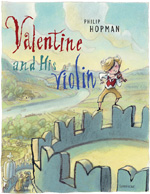 Valentine is learning to play the violin. As he attempts such classic pieces as “Ode to Joy” or “Water Music,” his music is actually more noise than melody. Everywhere he goes his audiences run from his cacophony; a dragon runs away, a horse bolts, a constipated wolf finds relief and more. Through it all, Valentine is confident and proud of his performances and is undeterred by audience reaction. However, the knight that watched the dragon flee asks Valentine to go with him to a battle where his castle is besieged and thinks Valentine might be able to help. When his music blares into the ears of the attacking soldiers they all run away to escape the deafening pain in their heads. The king and queen are grateful for his efforts to defeat the opposing army and so ask Valentine to perform at court. The illustrator has worked wonderful pen and ink and watercolor scenes of chaos into all this musical mayhem. Teachers might like to share with students some beginning violin music to hear what violins are supposed to sound like.
Valentine is learning to play the violin. As he attempts such classic pieces as “Ode to Joy” or “Water Music,” his music is actually more noise than melody. Everywhere he goes his audiences run from his cacophony; a dragon runs away, a horse bolts, a constipated wolf finds relief and more. Through it all, Valentine is confident and proud of his performances and is undeterred by audience reaction. However, the knight that watched the dragon flee asks Valentine to go with him to a battle where his castle is besieged and thinks Valentine might be able to help. When his music blares into the ears of the attacking soldiers they all run away to escape the deafening pain in their heads. The king and queen are grateful for his efforts to defeat the opposing army and so ask Valentine to perform at court. The illustrator has worked wonderful pen and ink and watercolor scenes of chaos into all this musical mayhem. Teachers might like to share with students some beginning violin music to hear what violins are supposed to sound like.
- Karen Hildebrand, Ohio Library and Reading Consultant
Markel, Michelle. (2012). The fantastic jungles of Henri Rousseau. Illus. by Amanda Hall. Grand Rapids, MI: Eerdmans.
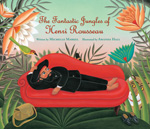 Henri Rousseau is a toll collector and he is 40 years old, but his dream is to become a painter. No one has ever told him that he could paint. It is simply his desire to become an artist. So, at age 40, he reinvents himself and begins to paint. He buys all the necessary art supplies and lets his imagination take flight. He paints gardens and jungle animals in a style that came to be known as naïve. His flattened shapes and the perspective that he brings to his canvas are unique. However, as he tries to win acceptance into the Parisian art world, he is ridiculed. His art is never really accepted in his own lifetime, though at one point Picasso honored him at a banquet in 1908. It was not until after Rousseau’s death that his style became renown. The illustrator has tried to recapture the essence of Rousseau’s exotic animals and naïve style using watercolors and acrylics to paint his jungle scenes. A discussion guide is available at the author’s website. Book trailer available at the publisher’s website or the extended five-minute trailer.
Henri Rousseau is a toll collector and he is 40 years old, but his dream is to become a painter. No one has ever told him that he could paint. It is simply his desire to become an artist. So, at age 40, he reinvents himself and begins to paint. He buys all the necessary art supplies and lets his imagination take flight. He paints gardens and jungle animals in a style that came to be known as naïve. His flattened shapes and the perspective that he brings to his canvas are unique. However, as he tries to win acceptance into the Parisian art world, he is ridiculed. His art is never really accepted in his own lifetime, though at one point Picasso honored him at a banquet in 1908. It was not until after Rousseau’s death that his style became renown. The illustrator has tried to recapture the essence of Rousseau’s exotic animals and naïve style using watercolors and acrylics to paint his jungle scenes. A discussion guide is available at the author’s website. Book trailer available at the publisher’s website or the extended five-minute trailer.
- Karen Hildebrand, Ohio Library and Reading Consultant
Moses, Will. (2011). Mary and her little lamb: The true story of the famous nursery rhyme. New York: Philomel Books.
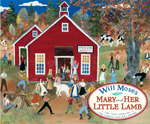 Almost every English-speaking child knows the famous nursery rhyme about Mary and her school-going lamb. But surprisingly, the rhyming lines are based on fact, not fiction. A little girl named Mary did, indeed, have an affectionate lamb that followed her everywhere, even to school. Most popular nursery rhymes have roots in the rhymes of Mother Goose or European folktales, but in this case, Thomas Edison immortalized Mary when he recited the lines that became the first words to be recorded in a phonogram. Mary was Mary Elizabeth Sawyer who lived on a farm with many kinds of animals to love. When she found and befriended a frail, newborn lamb, the two bonded, playing together during the summer. When the lamb followed her to school, and sat under her desk, John Roulstone, a school visitor, was inspired by the reaction of Mary’s classmates as she recited a poem in front of the class, lamb by her side. The students whistled, laughed, and clapped at the sight. Amused by the incident, he wrote the now-famous poem about Mary and her lamb. According to most sources, the rhyme was written in the 1810s. In the 1830s, a version with four stanzas (three were added to the original version) was published. Those who are interested may visit Mary’s red stone school in Sterling, MA. Read more information about the school and rhyme. The illustrations by Will Moses (a direct descendant of Grandma Moses) and the book’s simple text makes it an excellent cross-over for history and music units.
Almost every English-speaking child knows the famous nursery rhyme about Mary and her school-going lamb. But surprisingly, the rhyming lines are based on fact, not fiction. A little girl named Mary did, indeed, have an affectionate lamb that followed her everywhere, even to school. Most popular nursery rhymes have roots in the rhymes of Mother Goose or European folktales, but in this case, Thomas Edison immortalized Mary when he recited the lines that became the first words to be recorded in a phonogram. Mary was Mary Elizabeth Sawyer who lived on a farm with many kinds of animals to love. When she found and befriended a frail, newborn lamb, the two bonded, playing together during the summer. When the lamb followed her to school, and sat under her desk, John Roulstone, a school visitor, was inspired by the reaction of Mary’s classmates as she recited a poem in front of the class, lamb by her side. The students whistled, laughed, and clapped at the sight. Amused by the incident, he wrote the now-famous poem about Mary and her lamb. According to most sources, the rhyme was written in the 1810s. In the 1830s, a version with four stanzas (three were added to the original version) was published. Those who are interested may visit Mary’s red stone school in Sterling, MA. Read more information about the school and rhyme. The illustrations by Will Moses (a direct descendant of Grandma Moses) and the book’s simple text makes it an excellent cross-over for history and music units.
- Rani Iyer, Washington State University Pullman
Polacco, Patricia. (2012). The art of Miss Chew. New York: Penguin/Philomel Books.
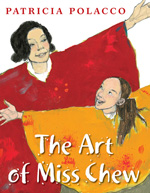 Once again, this gifted storyteller mines her formative years for an inspiring story about the impact of two supportive teachers. When her teacher Mr. Donovan notices that Trisha struggles while taking tests, he finds ways to accommodate her particular needs. Although Trisha is not proficient when it comes to reading and writing, she has no problem expressing herself through drawing. Mr. Donovan also takes note of her artistic talents and makes sure that she attends art classes at the high school. But when he must leave to return to Ireland, Trisha’s substitute teacher has no sympathy for the girl and blames her preoccupation with art for her poor schoolwork. This beautifully illustrated and carefully written picture book describes how Trisha’s art teacher, Miss Chew, nurtures her talents and how both she and Mr. Donovan bolster Trisha’s self-esteem. Essential reading for anyone who works with children or teens, this heart-rending story vividly illustrates the impact one person can have on another.
Once again, this gifted storyteller mines her formative years for an inspiring story about the impact of two supportive teachers. When her teacher Mr. Donovan notices that Trisha struggles while taking tests, he finds ways to accommodate her particular needs. Although Trisha is not proficient when it comes to reading and writing, she has no problem expressing herself through drawing. Mr. Donovan also takes note of her artistic talents and makes sure that she attends art classes at the high school. But when he must leave to return to Ireland, Trisha’s substitute teacher has no sympathy for the girl and blames her preoccupation with art for her poor schoolwork. This beautifully illustrated and carefully written picture book describes how Trisha’s art teacher, Miss Chew, nurtures her talents and how both she and Mr. Donovan bolster Trisha’s self-esteem. Essential reading for anyone who works with children or teens, this heart-rending story vividly illustrates the impact one person can have on another.
- Barbara A. Ward, Washington State University Pullman
Reynolds, Peter. (2012). Sky Color. Somerville, MA: Candlewick.
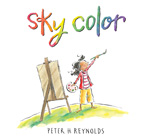 Reynolds has returned to his earlier The Dot (2003) and Ish (2004) with the newest companion in the set, Sky Color, to encourage young artists to paint what they see. Marisol and her classmates are excited to begin painting the mural in the school library. As each class member claims a different part of the mural to paint, Marisol wants to paint the sky. She is anxious to do this but then is dismayed to learn that there is no blue paint in the art box. When school is over, she ponders this problem as she looks out the window on her bus ride home that night. As she gazes out the window and observes the end of day sky she sees the vivid oranges and reds and yellows of late afternoon. That night she has a very colorful dream. When she wakes the next morning the sky is gray and it is raining but she has the solution to her sky problem. When she arrives at school she mixes the paints and designs a swirling spotty mixture of color across the sky in the mural. When one of her classmates asks her what kind of sky is that, she answers, “it’s sky color.” Reynolds illustrated the story using lots of gray and very little color until the scene where Marisol is looking out the school bus window. His subtle intent for children is to discover the colors in life and nature as observed through that window when Marisol realizes the sky is not always blue. See the detailed classroom guide. Learn more about the author and his book projects at his website or his new project to inspire the creativity in every child, The Dot Club. The Engage blog has a "Putting Books to Work" column featuring Reynolds’ Sky Color. Teachers might find this lesson at ReadWriteThink helpful as well: “The Natural World as Inspiration: An Outdoor Art Show.”
Reynolds has returned to his earlier The Dot (2003) and Ish (2004) with the newest companion in the set, Sky Color, to encourage young artists to paint what they see. Marisol and her classmates are excited to begin painting the mural in the school library. As each class member claims a different part of the mural to paint, Marisol wants to paint the sky. She is anxious to do this but then is dismayed to learn that there is no blue paint in the art box. When school is over, she ponders this problem as she looks out the window on her bus ride home that night. As she gazes out the window and observes the end of day sky she sees the vivid oranges and reds and yellows of late afternoon. That night she has a very colorful dream. When she wakes the next morning the sky is gray and it is raining but she has the solution to her sky problem. When she arrives at school she mixes the paints and designs a swirling spotty mixture of color across the sky in the mural. When one of her classmates asks her what kind of sky is that, she answers, “it’s sky color.” Reynolds illustrated the story using lots of gray and very little color until the scene where Marisol is looking out the school bus window. His subtle intent for children is to discover the colors in life and nature as observed through that window when Marisol realizes the sky is not always blue. See the detailed classroom guide. Learn more about the author and his book projects at his website or his new project to inspire the creativity in every child, The Dot Club. The Engage blog has a "Putting Books to Work" column featuring Reynolds’ Sky Color. Teachers might find this lesson at ReadWriteThink helpful as well: “The Natural World as Inspiration: An Outdoor Art Show.”
- Karen Hildebrand, Ohio Library and Reading Consultant
Rockliff, Mara. (2012). Me and Momma and Big John. Illus. by William Low. Somerville, MA: Candlewick.
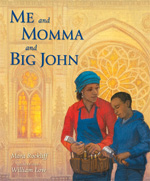 Momma used to work in a factory but now she is a stonecutter working on Big John, the cathedral in New York City called St. John the Divine. Each night, covered in dust, she tells her son John and his two siblings about her work at the unfinished cathedral and how excited she is to be part of this artistic sculptured work. When John and his sister and brother finally get to visit the cathedral, John is surprised that his mother’s sculpted stonecutting is not labeled or marked with a special sign for her contribution to this colossal monument. Momma explains how the work is her reward for being part of this wonderful architectural feat. The author’s message of pride in one’s work resonates through this project and Momma’s small but important part in the construction of the cathedral. The illustrator’s use of light and dark are effective in bringing out the features of the cathedral. An author’s note at the end fills out a little more of the back story explaining the apprenticeship program and the woman that inspired this true story. Learn more about the author and her books at her website or visit the Cathedral of St. John the Divine website.
Momma used to work in a factory but now she is a stonecutter working on Big John, the cathedral in New York City called St. John the Divine. Each night, covered in dust, she tells her son John and his two siblings about her work at the unfinished cathedral and how excited she is to be part of this artistic sculptured work. When John and his sister and brother finally get to visit the cathedral, John is surprised that his mother’s sculpted stonecutting is not labeled or marked with a special sign for her contribution to this colossal monument. Momma explains how the work is her reward for being part of this wonderful architectural feat. The author’s message of pride in one’s work resonates through this project and Momma’s small but important part in the construction of the cathedral. The illustrator’s use of light and dark are effective in bringing out the features of the cathedral. An author’s note at the end fills out a little more of the back story explaining the apprenticeship program and the woman that inspired this true story. Learn more about the author and her books at her website or visit the Cathedral of St. John the Divine website.
- Karen Hildebrand, Ohio Library and Reading Consultant
Saltzberg, Barney. (2012). Andrew drew and drew. New York: Harry N. Abrams.
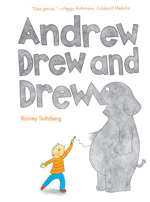 Like so many budding artists, young Andrew just can’t get enough of drawing. He starts with a simple line or sketch and follows it wherever it takes him, even across one page and onto another. Each page in this cleverly-designed book is filled with a line, a loop, even a stair step that Andrew has doodled on the paper, and the beginnings of his drawings often lead to something that even the artist himself doesn’t expect. The illustrations get more complicated and detailed throughout the book's pages as readers lift flap after flap to see where Andrew's lines have led. This simple yet inspiring book will delight young readers while reassuring them that it’s perfectly fine to go outside the lines and reminding them of the wonders of imagination. All they need is paper, a surface, and a pencil or two. A little bit of imagination and creativity keep Andrew from ever being bored.
Like so many budding artists, young Andrew just can’t get enough of drawing. He starts with a simple line or sketch and follows it wherever it takes him, even across one page and onto another. Each page in this cleverly-designed book is filled with a line, a loop, even a stair step that Andrew has doodled on the paper, and the beginnings of his drawings often lead to something that even the artist himself doesn’t expect. The illustrations get more complicated and detailed throughout the book's pages as readers lift flap after flap to see where Andrew's lines have led. This simple yet inspiring book will delight young readers while reassuring them that it’s perfectly fine to go outside the lines and reminding them of the wonders of imagination. All they need is paper, a surface, and a pencil or two. A little bit of imagination and creativity keep Andrew from ever being bored.
- Barbara A. Ward, Washington State University Pullman
Scanlon, Elizabeth Garton. (2012). Think big. Illus. by Vanessa Brantley Newton. New York: Bloomsbury.
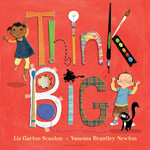 Young children are excited as they begin to prepare for their upcoming theater production of “When We Grow Up.” The assignment sheet is posted and the kids get busy. Illustrated in mixed media digital collage, charcoal and gouache each page features a different artistic contribution to the production. Children practicing dance steps, painting scenery, cooking, printing tickets and programs, rehearsing musical numbers, singing, sewing, crafting – all the multitude of tasks it takes to make a production ready for its audience. The variety in the vibrant illustrations and the sparse text on each page portray the hustle and bustle and many talents necessary to make a successful and entertaining show. The author has created a detailed teacher guide at her website.
Young children are excited as they begin to prepare for their upcoming theater production of “When We Grow Up.” The assignment sheet is posted and the kids get busy. Illustrated in mixed media digital collage, charcoal and gouache each page features a different artistic contribution to the production. Children practicing dance steps, painting scenery, cooking, printing tickets and programs, rehearsing musical numbers, singing, sewing, crafting – all the multitude of tasks it takes to make a production ready for its audience. The variety in the vibrant illustrations and the sparse text on each page portray the hustle and bustle and many talents necessary to make a successful and entertaining show. The author has created a detailed teacher guide at her website.
- Karen Hildebrand, Ohio Library and Reading Consultant
Schubert, Leda. (2012). Monsieur Marceau: Actor without words. Illus. by Gerard DuBois. New York: Macmillan/Flashpoint.
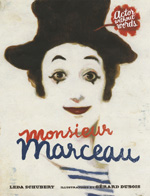 Appropriately enough, given the subject, this picture book biography is filled with simple but expressive full-color illustrations of gestures and facial expressions showing a wide range of human emotions. Because Marcel Marceau was known for his ability to tell stories through miming, the illustrations follow suit as they help tell his life story. Not only does the book describe how Marceau learned to mime, but the author also includes information on Marceau's secret efforts against the Nazis during the Holocaust when he helped lead Jewish children hidden in an orphanage to freedom. It also briefly notes his decision to change his last name from Mangel to Marceau to avoid prejudices against the Jews. This introductory book about a man who became a mime master also includes directions on first steps to begin miming, something sure to delight readers and teachers.
Appropriately enough, given the subject, this picture book biography is filled with simple but expressive full-color illustrations of gestures and facial expressions showing a wide range of human emotions. Because Marcel Marceau was known for his ability to tell stories through miming, the illustrations follow suit as they help tell his life story. Not only does the book describe how Marceau learned to mime, but the author also includes information on Marceau's secret efforts against the Nazis during the Holocaust when he helped lead Jewish children hidden in an orphanage to freedom. It also briefly notes his decision to change his last name from Mangel to Marceau to avoid prejudices against the Jews. This introductory book about a man who became a mime master also includes directions on first steps to begin miming, something sure to delight readers and teachers.
- Barbara A. Ward, Washington State University Pullman
Stanbridge, Joanne. (2012). The Extraordinary Music of Mr. Ives: The true story of a famous American Composer. Boston, MA: Houghton Mifflin Harcourt.
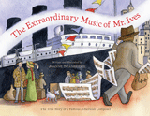 The ocean liner, the Lusitania, sank in 1915 and people in the United States were shocked. Charles Ives composed a song that reflected the shock, sadness and grief at the loss of lives when this ship went down. Several wordless pages direct the dramatic impact at the sinking of the Lusitania however one panel focuses on the rescue of a young girl and her mother that offers some hope. Author’s notes, source lists, and lists for further reading and listening are included at the end of the book to help fill in the historical significance of this tragic event and how Ives’ work inspired other composers in later years. Read more background information on Mr. Ives can be found. ReadWriteThink offers a lesson plan entitled: “Read a Song; Using Song Lyrics for Reading and Writing.”
The ocean liner, the Lusitania, sank in 1915 and people in the United States were shocked. Charles Ives composed a song that reflected the shock, sadness and grief at the loss of lives when this ship went down. Several wordless pages direct the dramatic impact at the sinking of the Lusitania however one panel focuses on the rescue of a young girl and her mother that offers some hope. Author’s notes, source lists, and lists for further reading and listening are included at the end of the book to help fill in the historical significance of this tragic event and how Ives’ work inspired other composers in later years. Read more background information on Mr. Ives can be found. ReadWriteThink offers a lesson plan entitled: “Read a Song; Using Song Lyrics for Reading and Writing.”
- Karen Hildebrand, Ohio Library and Reading Consultant
Zalben, Jane Breskin. (2012). Mousterpiece. New York: Roaring Brook Press.
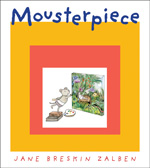 Janson the mouse lives in a corner of the art museum. Each night she explores. One night she comes upon a part of the museum she has never seen before that contains the modern art wing. She is amazed at the art work and a whole new world opens up for her. Shortly, that wing is closed for renovation and she is cut off from her new discoveries. However, this spurs her to create her own art. Soon we see paintings from Janson that look unsurprisingly familiar – spinoffs from the masters she observed in the modern art wing. When the director of the museum finds her artwork he arranges for an exhibit of her work, especially those pieces that are actually her own original style. The end of the book features thumbnail pictures and information of all the artists that Janson enjoyed during her tour of the modern art wing. Check out the activities the author has prepared on her website. Teachers will enjoy the article by T. Lee Williams from Reading Teacher (2007) entitled: “'Reading' the painting: Exploring visual literacy in the primary grades."
Janson the mouse lives in a corner of the art museum. Each night she explores. One night she comes upon a part of the museum she has never seen before that contains the modern art wing. She is amazed at the art work and a whole new world opens up for her. Shortly, that wing is closed for renovation and she is cut off from her new discoveries. However, this spurs her to create her own art. Soon we see paintings from Janson that look unsurprisingly familiar – spinoffs from the masters she observed in the modern art wing. When the director of the museum finds her artwork he arranges for an exhibit of her work, especially those pieces that are actually her own original style. The end of the book features thumbnail pictures and information of all the artists that Janson enjoyed during her tour of the modern art wing. Check out the activities the author has prepared on her website. Teachers will enjoy the article by T. Lee Williams from Reading Teacher (2007) entitled: “'Reading' the painting: Exploring visual literacy in the primary grades."
- Karen Hildebrand, Ohio Library and Reading Consultant
GRADES 4-6
Burleigh, Robert. (2012). George Bellows: Painter with a punch! New York: Harry H. Abrams.
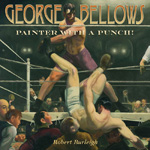 This biography shares the life of realistic painter George Bellows. During the early 1900s George wandered the largest city in America, New York, using all of his senses to observe and capture the lives of ordinary people. He noticed chaotic and congested streets, grungy saloons, overcrowded tenement buildings, filthy alleyways, and busy construction sites. In art school he learned that an artist could disturb, upset, and enlighten by painting what struck them as worthy. He decided to paint the city as it really was, from unusual points of view. For example, during this time boxing was an illegal sport because city leaders felt it was too violent. George was able to capture the gritty underworld in Stag at Sharkey’s, with two fighters battling it out in a ring and spectators intensely watching. George committed these scenes to memory and then returned to his studio to a blank canvas. In addition, he painted landscapes, portraits, and the horrors of war. George Bellows’ paintings are considered contributions to American art history. The back matter in this book includes where his works are displayed across the United States, sources, bibliography, illustration credits, and an index.
This biography shares the life of realistic painter George Bellows. During the early 1900s George wandered the largest city in America, New York, using all of his senses to observe and capture the lives of ordinary people. He noticed chaotic and congested streets, grungy saloons, overcrowded tenement buildings, filthy alleyways, and busy construction sites. In art school he learned that an artist could disturb, upset, and enlighten by painting what struck them as worthy. He decided to paint the city as it really was, from unusual points of view. For example, during this time boxing was an illegal sport because city leaders felt it was too violent. George was able to capture the gritty underworld in Stag at Sharkey’s, with two fighters battling it out in a ring and spectators intensely watching. George committed these scenes to memory and then returned to his studio to a blank canvas. In addition, he painted landscapes, portraits, and the horrors of war. George Bellows’ paintings are considered contributions to American art history. The back matter in this book includes where his works are displayed across the United States, sources, bibliography, illustration credits, and an index.
- Deanna Day, Washington State University Vancouver
Greenwald, Tommy. (2012). Charlie Joe Jackson’s Guide to Extra Credit. New York: Roaring Brook Press.
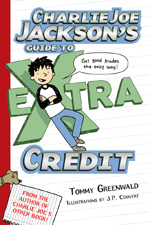 Still not a fan of reading, Charlie Joe must come up with a plan to avoid being sent to a summer reading camp once his grades slip again. In this follow-up to last year's Charlie Joe Jackson's Guide to Not Reading the world’s most reluctant reader negotiates a compromise with his parents. There will be no summer reading camp for him if his grades improve during the next marking period. Since Charlie Joe is fearful of relying on studying and having help from his friends, he follows his sister's advice to ask his teachers for extra credit. His pursuit of extra points leads to hilarious scenes in which he poses in a pair of exceptionally tight and brief shorts for his art teacher, tries out and wins the male lead in the school play, and even joins the student council. Naturally, all of this extra credit translates into extra trouble for Charlie Joe. There are many amusing scenes surrounding Paper Tiger, the school musical, as well as considerable drama about affairs of the heart. While much of this book will appeal to boy readers, the female characters are equally interesting, especially new girl Zoe who sticks up for herself and calls bullies to account for their actions. Even those who hate to read may see themselves in the book and having decided to read a page or two, just may keep on reading. Readers should be forewarned, though: This book will produce embarrassing guffaws and snorts of glee.
Still not a fan of reading, Charlie Joe must come up with a plan to avoid being sent to a summer reading camp once his grades slip again. In this follow-up to last year's Charlie Joe Jackson's Guide to Not Reading the world’s most reluctant reader negotiates a compromise with his parents. There will be no summer reading camp for him if his grades improve during the next marking period. Since Charlie Joe is fearful of relying on studying and having help from his friends, he follows his sister's advice to ask his teachers for extra credit. His pursuit of extra points leads to hilarious scenes in which he poses in a pair of exceptionally tight and brief shorts for his art teacher, tries out and wins the male lead in the school play, and even joins the student council. Naturally, all of this extra credit translates into extra trouble for Charlie Joe. There are many amusing scenes surrounding Paper Tiger, the school musical, as well as considerable drama about affairs of the heart. While much of this book will appeal to boy readers, the female characters are equally interesting, especially new girl Zoe who sticks up for herself and calls bullies to account for their actions. Even those who hate to read may see themselves in the book and having decided to read a page or two, just may keep on reading. Readers should be forewarned, though: This book will produce embarrassing guffaws and snorts of glee.
- Barbara A. Ward, Washington State University Pullman
Mack, Lorrie. (2012). Dance: From ballet to breakin’—step into the dazzling world of dance. New York: DK Books.
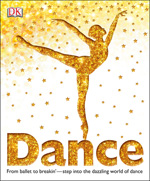 For all dance enthusiasts and/or novices, this book will amaze and astound, because of the bright photographs and detailed information. The book begins with dancing around the world where dance has helped people celebrate and express their national identity throughout history. Other chapters highlight strictly ballroom, classical ballet, barefoot and full of feeling, the magic of musicals and conclude with breakin’ and street. Each page contains bold headings, subheadings, textboxes, photographs, captions, and sidebars making this an educational feast of material. For example, one page titled “Ballroom class” shows the elegant lines dancers make with their bodies titled: oversway, throwaway, contra check, and hinge. Each of these lines are described in a paragraph with accompanying photographs. A sidebar discusses the unique ballroom holds from closed to tango. Another text box discusses baby ballroom dancing. Finally, 16 small photographs displayed in a timeline, show the basic steps of the rumba routine in order. Young dancers could easily follow these steps to recreate this form. The final section discusses street dance inspired by disco, funk, and hip-hop. One full page spread outlines how break dance began in the 1970s to how it is addressed in movies today. Pop performers are highlighted showcasing some of their different dance styles. A glossary, index, and acknowledgments page closes the book.
For all dance enthusiasts and/or novices, this book will amaze and astound, because of the bright photographs and detailed information. The book begins with dancing around the world where dance has helped people celebrate and express their national identity throughout history. Other chapters highlight strictly ballroom, classical ballet, barefoot and full of feeling, the magic of musicals and conclude with breakin’ and street. Each page contains bold headings, subheadings, textboxes, photographs, captions, and sidebars making this an educational feast of material. For example, one page titled “Ballroom class” shows the elegant lines dancers make with their bodies titled: oversway, throwaway, contra check, and hinge. Each of these lines are described in a paragraph with accompanying photographs. A sidebar discusses the unique ballroom holds from closed to tango. Another text box discusses baby ballroom dancing. Finally, 16 small photographs displayed in a timeline, show the basic steps of the rumba routine in order. Young dancers could easily follow these steps to recreate this form. The final section discusses street dance inspired by disco, funk, and hip-hop. One full page spread outlines how break dance began in the 1970s to how it is addressed in movies today. Pop performers are highlighted showcasing some of their different dance styles. A glossary, index, and acknowledgments page closes the book.
- Deanna Day, Washington State University, Vancouver
Nobleman, Marc Tyler. (2012). Bill the boy wonder: The secret co-creator of Batman. Illus. by Ty Templeton. Watertown, MA: Charlesbridge.
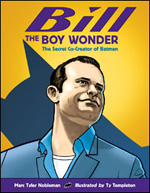 The Batman featured in today’s comic books and films is not the Batman he started out to be. In fact, the man credited for the character and story of this heroic figure is not the sole creator of the comic. Tantalizingly, there is a story behind the story of the birth of Batman that is every bit as intriguing as the caped wonder. This partial picture book biography describes the influence of Bill Finger, one of the men who, along with Bob Kane, helped create Batman. Although the two worked together on Batman’s storylines and image, Bob received all the recognition and most of the money for the comic. In fact, Bill's name never even appeared on the comic book stories that he wrote. Not only is this thoroughly researched story of artistic injustice intriguing and almost worthy of a comic itself, but the description of how hard the author worked to uncover details about what happened decades ago, is inspiring. He even managed to locate Finger's granddaughter by following every possible trail, even the most unlikely ones. Reminiscent of the pages in a comic book, the illustrations in the book were created with artist pens and colored in Photoshop. Fans of Batman will be thrilled to see justice served as Bill Finger finally gets a small share of the attention he deserves for bringing Batman to life.
The Batman featured in today’s comic books and films is not the Batman he started out to be. In fact, the man credited for the character and story of this heroic figure is not the sole creator of the comic. Tantalizingly, there is a story behind the story of the birth of Batman that is every bit as intriguing as the caped wonder. This partial picture book biography describes the influence of Bill Finger, one of the men who, along with Bob Kane, helped create Batman. Although the two worked together on Batman’s storylines and image, Bob received all the recognition and most of the money for the comic. In fact, Bill's name never even appeared on the comic book stories that he wrote. Not only is this thoroughly researched story of artistic injustice intriguing and almost worthy of a comic itself, but the description of how hard the author worked to uncover details about what happened decades ago, is inspiring. He even managed to locate Finger's granddaughter by following every possible trail, even the most unlikely ones. Reminiscent of the pages in a comic book, the illustrations in the book were created with artist pens and colored in Photoshop. Fans of Batman will be thrilled to see justice served as Bill Finger finally gets a small share of the attention he deserves for bringing Batman to life.
- Barbara A. Ward, Washington State University Pullman
Vaughan, Carolyn. (2012, 2011). Invitation to ballet: A celebration of dance and Degas. Works of art by Edgar Degas. Illustrations by Rachel Isadora. Abrams Books for Young Readers. Honesdale, PA: Lemniscaat/Boyds Mill Press.
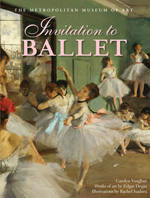
This beautifully illustrated book is an introduction to ballet enhanced by the accompanying paintings of Edgar Degas. Each chapter explains this delicate dance from preparing for class and learning what to wear to the descriptions of steps and leaps explained for better understanding of the overall ballet performance. The history of ballet as well as biographical information on the artist, Edgar Degas and the numerous paintings of ballerinas in various moments of the dance create a visual treat to complement the text. Learn more about Degas and the ballerinas he paints at The Philadelphia Museum of Art or view this YouTube video of the Degas ballerinas.
- Karen Hildebrand, Ohio Library and Reading Consultant
GRADES 9-12
Tashjian, Janet. (2012). For what it’s worth. New York: Henry Holt.
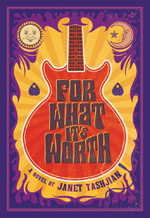 The lives of many teens revolve around music, but for fourteen-year-old Quinn, nothing else matters more than discovering, collecting, playing, and writing about rock and roll. He even revels in the artistry of the album covers for the records he loves so much. Since the story is set in 1971 and 1972 in Los Angeles's Laurel Canyon, where many musicians hung out or lived, Quinn has grown up knowing or seeing many of them. When he starts falling for new girl Caroline, he thinks twice since she knows so little about the music he loves. But he tutors her in music, and they grow closer despite his doubts about her faithfulness, in part because of messages he receives from his Ouija board. Against his will, his social consciousness is raised by through the intense class discussions of current events and provocative news photos shared by Mr. Woodrow, a substitute teacher in history class. As Quinn is drawn into political activism because of his older sister's friendship with a draft resister heading to Canada rather than Vietnam, conflict escalates on the home front. Interspersed amid all this drama are Quinn’s "For What It's Worth" columns containing written sketches of the musicians of the time--Cass Elliot [his mother’s childhood friend], Jimi Hendrix, Janis Joplin, Jim Morrison, Pete Townshend, Frank Zappa, and more. As first loves and possible betrayals simmer in the background, the author brings the time period to life through authentic details such as the still-pulsing paranoia about the murders committed by Charles Manson’s followers a few months earlier as well as the emerging news stories about the Watergate break-ins near the story's end. The power of music and art to encapsulate a time period permeates the book’s pages as one photograph in particular moves Quinn in an unexpected way. In the similar way that some song lyrics refuse to be banished from your head, this book will prick at your conscience long after it finished playing. Here’s betting few readers can’t resist listening to Quinn’s favorite music while reading it.
The lives of many teens revolve around music, but for fourteen-year-old Quinn, nothing else matters more than discovering, collecting, playing, and writing about rock and roll. He even revels in the artistry of the album covers for the records he loves so much. Since the story is set in 1971 and 1972 in Los Angeles's Laurel Canyon, where many musicians hung out or lived, Quinn has grown up knowing or seeing many of them. When he starts falling for new girl Caroline, he thinks twice since she knows so little about the music he loves. But he tutors her in music, and they grow closer despite his doubts about her faithfulness, in part because of messages he receives from his Ouija board. Against his will, his social consciousness is raised by through the intense class discussions of current events and provocative news photos shared by Mr. Woodrow, a substitute teacher in history class. As Quinn is drawn into political activism because of his older sister's friendship with a draft resister heading to Canada rather than Vietnam, conflict escalates on the home front. Interspersed amid all this drama are Quinn’s "For What It's Worth" columns containing written sketches of the musicians of the time--Cass Elliot [his mother’s childhood friend], Jimi Hendrix, Janis Joplin, Jim Morrison, Pete Townshend, Frank Zappa, and more. As first loves and possible betrayals simmer in the background, the author brings the time period to life through authentic details such as the still-pulsing paranoia about the murders committed by Charles Manson’s followers a few months earlier as well as the emerging news stories about the Watergate break-ins near the story's end. The power of music and art to encapsulate a time period permeates the book’s pages as one photograph in particular moves Quinn in an unexpected way. In the similar way that some song lyrics refuse to be banished from your head, this book will prick at your conscience long after it finished playing. Here’s betting few readers can’t resist listening to Quinn’s favorite music while reading it.
- Barbara A. Ward, Washington State University Pullman
Telgemeier, Raina. (2012). Drama. New York: Scholastic/Graphix.
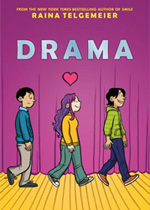 This graphic novel by the author of Smile (2010) focuses on an aspect of the theater world that receives little recognition--the hard-working, creative stage crew. The book's seventh grade protagonist Callie is integral to Eucalyptus Middle School’s theatrical program. As often happens during preparation for a new show, there is just as much drama off stage as there is on stage during rehearsals for the school musical, Moon over Mississippi. Callie's crush on a classmate's older brother is unrequited, and she finds solace in her work on the set, her best friend Liz, and talented thespian twins Justin and Jesse. Justin wins a role in the musical, but Jesse prefers to help out backstage, and Callie imagines romantic possibilities with him. When an unexpected break-up right before the final show prompts the lead actress to flee the stage, someone must step into her role. The author depicts these complex middle graders perfectly, complete with the drama that occurs outside school lockers or during school dances. As Callie endures humiliation after humiliation sparked by misunderstandings and at times by classmates in search of sexual identity, her backstage work provides sustenance. Filled with humor, special moments and interesting, sometimes surprising characters, Drama may spark interest in set design in teen readers impressed with the creative contributions and swiftness with which the stage crew moves parts of the set and props onto and off the stage.
This graphic novel by the author of Smile (2010) focuses on an aspect of the theater world that receives little recognition--the hard-working, creative stage crew. The book's seventh grade protagonist Callie is integral to Eucalyptus Middle School’s theatrical program. As often happens during preparation for a new show, there is just as much drama off stage as there is on stage during rehearsals for the school musical, Moon over Mississippi. Callie's crush on a classmate's older brother is unrequited, and she finds solace in her work on the set, her best friend Liz, and talented thespian twins Justin and Jesse. Justin wins a role in the musical, but Jesse prefers to help out backstage, and Callie imagines romantic possibilities with him. When an unexpected break-up right before the final show prompts the lead actress to flee the stage, someone must step into her role. The author depicts these complex middle graders perfectly, complete with the drama that occurs outside school lockers or during school dances. As Callie endures humiliation after humiliation sparked by misunderstandings and at times by classmates in search of sexual identity, her backstage work provides sustenance. Filled with humor, special moments and interesting, sometimes surprising characters, Drama may spark interest in set design in teen readers impressed with the creative contributions and swiftness with which the stage crew moves parts of the set and props onto and off the stage.
- Barbara A. Ward, Washington State University Pullman
These reviews are submitted by members of the International Reading Association's Children's Literature and Reading Special Interest Group (CL/R SIG) and are published weekly on Reading Today Online. The International Reading Association partners with the National Council of Teachers of English and Verizon Thinkfinity to produce ReadWriteThink.org, a website devoted to providing literacy instruction and interactive resources for grades K–12.